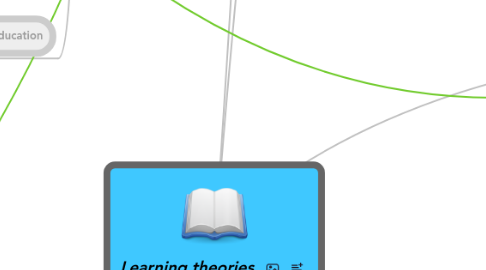
1. Cognitivism
1.1. Piaget and Individual Cognition
1.1.1. Instructors have to take into account the role that fundamental concepts, such as the permanence of objects, play in establishing cognitive structures. Source: www.funderstanding.com
1.2. La Gestalt
1.2.1. "The whole is greater than the sum of its parts"
1.2.1.1. Holistic/global experiences for development
1.2.1.1.1. Thinking as productive or reproductive
1.3. Wittrock's generative learning model
1.3.1. The brain operates through processes of generating meaningful relations “among concepts and between knowledge and experience” http://interarchdesign.wordpress.com/2007/11/11/wittrock-generative-learning-processes-of-the-brain/
1.4. Brain-based learning
1.4.1. Learning must meet the physiological functions of the brain. Source: Fortner 2004
1.4.2. Braingym
1.4.2.1. 1974
1.4.3. ICT implications
1.4.3.1. Promotes multitasking which can be incorporated into ICT tasks.
1.5. Control Theory
1.5.1. You can meet students’ needs for belonging and control by involving them in decisions that concern them. Source: Bluestien, Glasser
1.6. Gardner's Multiple Intelligences
1.6.1. Spatial
1.6.1.1. Siftables
1.6.1.2. Simulations
1.6.1.3. Classroom Environment
1.6.2. Linguistic
1.6.2.1. Siftables
1.6.2.2. Podcasts
1.6.2.3. Blogs/ Forums/ Chat
1.6.3. Logical-Mathematical
1.6.3.1. Spreadsheets
1.6.3.2. Simulations
1.6.3.3. Siftables
1.6.4. Bodily-Kinestheitc
1.6.4.1. Siftables
1.6.4.2. Laboratory Equipment
1.6.5. Musical
1.6.5.1. Siftables
1.6.5.2. Electronic Instruments
1.6.5.3. Garage Band
1.6.6. Interpersonal
1.6.6.1. Blogs
1.6.6.2. Forums
1.6.6.3. Chat
1.6.6.4. Online Collaboration tools (e.g. Brainstorming)
1.6.7. Intrapersonal
1.6.7.1. Self-Analysis Brainstorming
1.6.7.2. Personality/ Intelligence Testing
1.6.7.3. Reflection Blogs
1.6.8. Naturalistic
1.6.8.1. Natural Simulations
1.6.8.2. Interacting with like-minded people and groups online
1.6.8.3. World Events - Environmental Issues
1.6.9. Existential
1.6.9.1. Debate
1.6.9.2. Philosophical Forums
1.6.9.3. Explorations of Scale - the very small to the very large
1.6.10. Theory lacks substantial evidence. Brain is not a set of functional compartments.
1.7. ICT Connections
1.7.1. Technology and Learner both enhanced
1.8. Right brain vs. Left brain
1.8.1. Left brain
1.8.1.1. Logical Sequential, Rational, Analytical, Objective, Looks at parts.
1.8.1.1.1. Schools tend to favor left-brain modes of thinking http://www.funderstanding.com/content/about-learning
1.8.2. Right brain
1.8.2.1. Random, Intuitive, Holistic Synthesizing, Subjective, Looks at wholes.
1.9. Imaginative education
1.9.1. Cultural tools are cognitive tools for each of us http://www.ierg.net/about/cog_thoughts.html
1.9.1.1. Somatic understanding, Mythic Understanding, Romantic Understanding, Philisophic Understanding, Ironic understanding
2. Behaviourism
2.1. Sequencing (of learning activities)
2.2. Pavlov (conditioned learning)
2.3. Observational
2.4. Its positive and negative reinforcement techniques can be very effective. Source: www.funderstanding.com
2.5. Date:
2.5.1. Proponents:
2.6. ICT Connections
2.6.1. Technology acts as a stimulus; a recorder of response; a means of skill practice; and a way to receive feedback and practice to perfection
2.6.2. Operant conditioning may promote or discourage the use of ICT.
3. Neuroscience
3.1. When educators take neuroscience into account, they organize a curriculum around real experiences and integrated, “whole” ideas. Source: www.funderstanding.com
3.2. Complex thinking abilities may be developed throughout life
3.2.1. Impact on the model of teachers as "all knowing" beings.
4. Made by us!
4.1. Christopher
4.2. Malcolm
4.3. Ingrid
4.4. Gavin
5. Constructivism
5.1. Instruction–Under the theory of constructivism, educators focus on making connections between facts and fostering new understanding in students. Assessment becomes part of the learning process so that students play a larger role in judging their own progress. Source: www.funderstanding.com
5.2. Vygotsky and Social Cognition
5.2.1. Two children might have the same level of actual development, but given the appropriate help from an adult, one might be able to solve many more problems than the other. Source: www.funderstanding.com
5.2.1.1. Zone of proximal development
5.2.2. In contrast to Jean Piaget’s understanding of child development (in which development necessarily precedes learning), Vygotsky felt social learning precedes development. Source: www.learning-theories.com
5.2.2.1. Sensorimotor stage, Preoperational stage, Concrete operations, Formal operations
5.3. ICT Connections
5.3.1. Technology is used to struggle with and encounter new ideas and evidence that may contradict prior experiences; to incorporate new information with the learner's pre-existing conceptions; and to arrive at a new or modified understanding
5.4. Actor-Network-Theory
5.4.1. A view of an overall interaction as a construction of multiple smaller and inter-related connections. These internal interactions can be between things (material-based) or between concepts (semiotic). The inter-relationships between the material and semiotic relations form a network of interactions. The network as an entity forms the overall interaction, which is therefore simultaneously material and semiotic.
5.4.2. Technology can be used to form the network. The interface for the technology allows access to the network for the actor(s).
5.4.2.1. Computers not seen as objects but rather as tools that when used adequately provide an advantage
5.5. Constructivism has become educations version of the grand unified theory - Micheal Matthews http://www.csi.unian.it/edua/inglese/matthews.html
5.6. Model-Dependent Realism
5.6.1. "... our brains interpret the input from our sensory organs by making a model of the world" - Hawking, S. W., & Leonard Mlodinow. (2010). The Mystery of Being. The Grand Design. New York: Bantam. Print.
6. Learning Styles
6.1. Traditional schooling tends to favor abstract perceiving and reflective processing. www.funderstanding .com/ content/about-learning
6.2. BBC 4 Radio program
6.3. strategies, or regular mental behaviours, habitually applied by an individual to problem-solving. Source: Prichard 2009 Ways of Learning
7. Reference Books (Online)
7.1. Secondary Education : The Key Concepts
7.2. Learning Theories
8. Motivational Theory
8.1. ARCS model
8.1.1. Attention
8.1.1.1. Perceptual
8.1.1.1.1. Novel events to draw interest
8.1.1.2. Inquiry-based
8.1.1.2.1. Challenging events to draw interest
8.1.2. Relevance
8.1.2.1. Associations to present or future applications in order to increase motivation
8.1.3. Confidence
8.1.3.1. Provide realistic measures to success in which the learner can self assess this component
8.1.4. Satisfaction
8.1.4.1. Learning must be encountered as a useful skill - not a pattern or a chore
8.2. ICT implications
8.2.1. Demands careful design of ICT activities that are truly meaningful to the learner.
